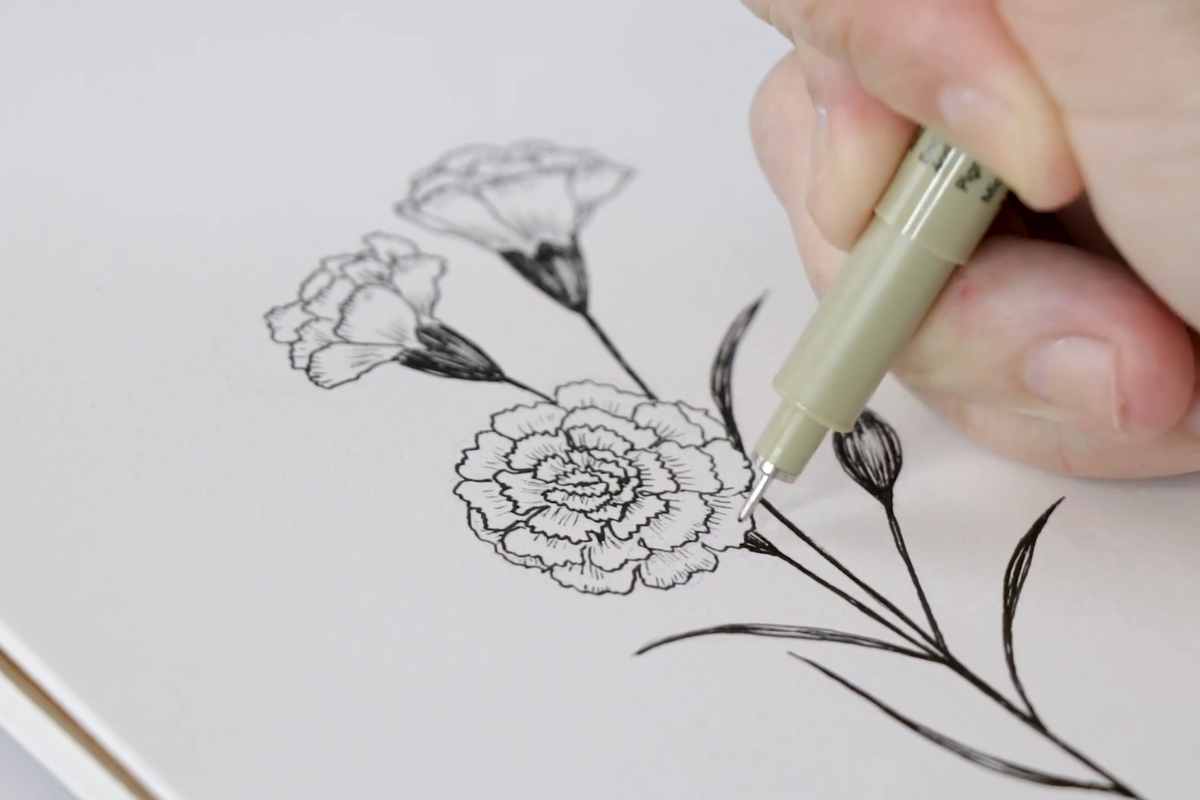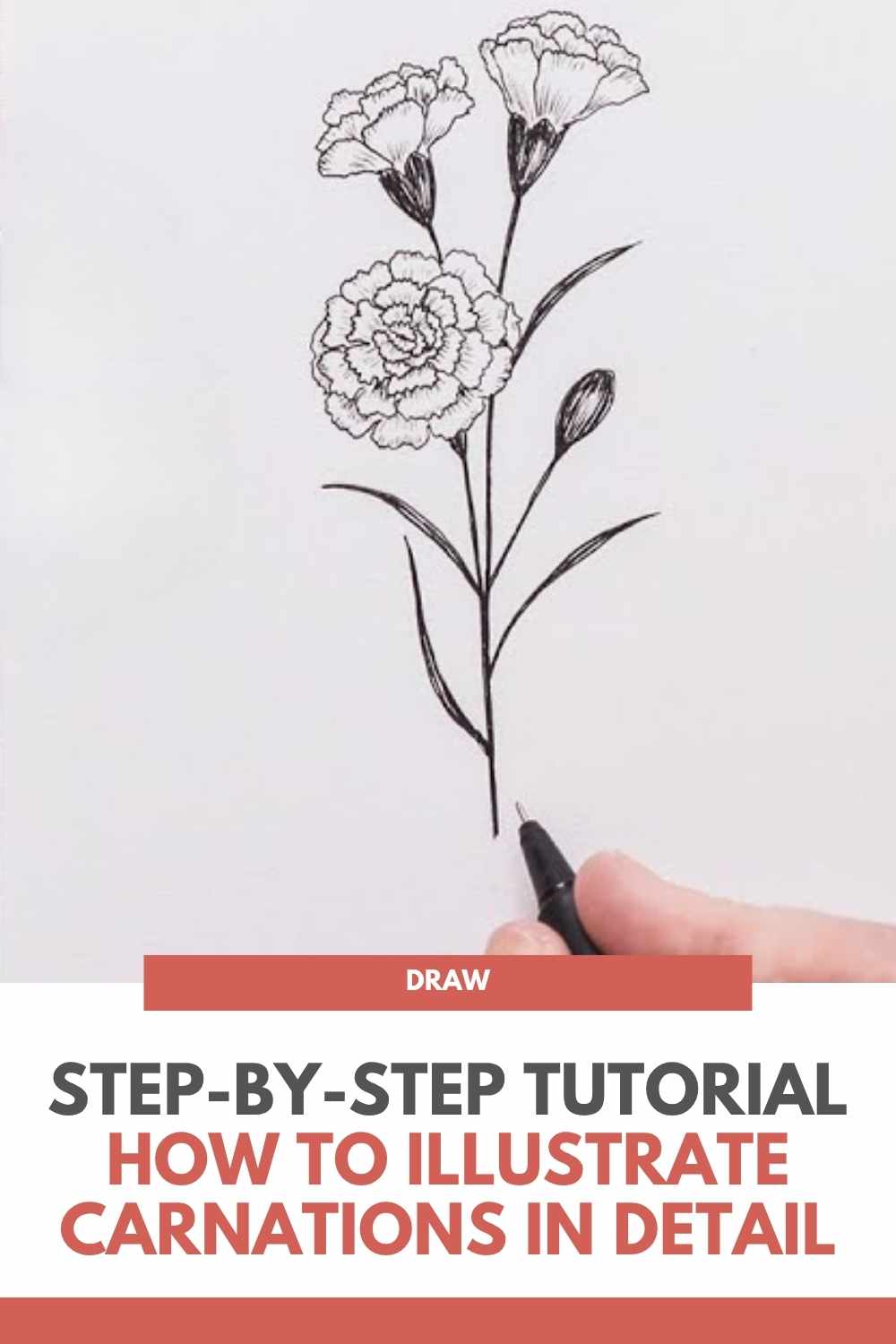Step-by-Step Tutorial: How to Illustrate Carnations in Detail

Drawing flowers can seem intimidating, especially when it comes to intricate blooms like carnations. However, with the right approach, carnations can actually be one of the easiest and most rewarding flowers to draw. This tutorial is by Shayda Campbell.
In this article, we’ll walk through the process of creating beautiful, detailed carnations using simple techniques that anyone, from beginners to experienced artists, can master.
Why Draw Carnations?
Carnations are beloved flowers known for their layered petals and beautiful ruffled textures. Their intricate design may appear challenging at first, but their structure is actually quite simple once broken down into smaller steps.
Not only are carnations visually striking, but they also symbolize love and admiration, making them a meaningful subject for art.
The Appeal of Drawing Carnations
When it comes to floral illustrations, carnations are a perfect choice due to their delicate yet dynamic structure. The petals create depth and volume, which can be captured beautifully with different shading and layering techniques.
Drawing carnations can also help develop your skills in creating texture and working with line quality, both of which are essential for all types of botanical illustration.
 Shayda Campbell (@shaydacampbell)
Shayda Campbell (@shaydacampbell)
Understanding the Structure of Carnations
Before diving into the drawing process, it’s important to understand the basic structure of a carnation. Observing how the petals layer upon each other, creating a full and rounded appearance, will help you capture their essence accurately.
Carnations have a distinctive look, with their frilled edges and tightly packed petals that spiral outward from the center.
Breaking Down the Flower into Basic Shapes
One of the keys to drawing carnations with ease is to start by simplifying the flower into basic shapes. Think of the flower as a series of curved lines and rounded shapes that build upon one another.
By focusing on these fundamental forms, you can create the overall structure without getting lost in details too early.
The outer petals are the largest and most dramatic, gradually tapering off as you move inward toward the center of the flower. The stem and leaves are also essential elements to include in your drawing for a balanced and complete composition.
Tools and Materials for Drawing
You don’t need a lot of fancy tools to draw a beautiful carnation. The following materials are great for achieving clean, detailed lines and smooth shading:
Essential Drawing Tools
Pencils: Start with a light pencil (like a 2H) for your initial sketch, and use a darker pencil (such as a 4B or 6B) for shading and adding depth.
Eraser: A kneaded eraser is perfect for gently lifting excess graphite and adding highlights.
Paper: A smooth drawing paper or sketchbook with enough weight to handle erasing and layering is ideal.
Using the right tools will help you achieve the clean, crisp lines that carnations require, while also giving you the flexibility to refine your drawing as you go.
 Shayda Campbell (@shaydacampbell)
Shayda Campbell (@shaydacampbell)
Techniques for Drawing Carnations
Now that you have your materials, let’s break down the techniques that will help you bring your carnation drawing to life.
Start with the Basic Shape
As mentioned, begin by drawing the basic outline of the flower with a light pencil. Don’t worry about perfect detail at this stage. Focus on the overall shape, and sketch the basic petal arrangement, keeping the lines loose and fluid.
Layering Petals and Building Texture
Carnations are known for their frilled and ruffled petals, so it's essential to use layered lines to replicate this texture. Start by adding the larger outer petals, gradually working your way toward the smaller inner petals. Pay attention to how each layer overlaps the one beneath it.
As you draw, use curved lines to mimic the natural flow of the petals. Focus on creating gentle curves and varying the line thickness to give the petals a natural, organic feel. The use of softer, lighter lines on the edges will help create a more realistic texture.
Adding Depth with Shading
Shading is crucial for creating the depth and dimension that make your carnation appear lifelike.
Start by identifying the light source in your drawing and add shading on the opposite side of the petals and the flower’s interior. Use a softer pencil for shading, gradually building up darker areas to create contrast.
Use hatching or cross-hatching to add shadows, paying attention to the natural folds and curves of the petals. To make your flower stand out, you can also shade the base of the stem and leaves to give the drawing a three-dimensional effect.
Fine Details and Highlights
The final step is to add the finer details that make the carnation truly stand out. For the petals, you can use delicate lines to show the subtle veins and textures.
Make sure to also highlight the edges of the petals where light hits, using an eraser to lift some graphite and brighten up certain areas.
If you’re working in color, this is the moment to carefully layer soft color washes for the petals and leaves, starting with lighter hues and building up darker tones as needed.
For a more dramatic effect, you can use colored pencils or even watercolor to add vibrant color while maintaining the delicate textures created with the pencil.
Why Carnations Are Great for Beginners
Drawing carnations is a wonderful exercise for artists of all levels, especially for beginners. Not only do they allow for an exploration of shading techniques and layering, but the step-by-step approach to creating the petals and structure makes them a manageable yet rewarding challenge.
With just a few basic guidelines, you can create a detailed, beautiful flower that will help improve your overall drawing skills.
 Shayda Campbell (@shaydacampbell)
Shayda Campbell (@shaydacampbell)
Conclusion: Drawing Beautiful Carnations
With these helpful techniques, you can start drawing realistic carnations with ease. Whether you're using graphite or adding color, the process of layering, shading, and refining each petal will help you build a beautiful illustration.
Carnations may seem complex, but by breaking them down into simple shapes and focusing on the details, you’ll find that they are one of the most satisfying flowers to draw.
So, grab your sketchbook and pencils, and start creating your own stunning floral illustrations! Whether you’re drawing just one carnation or a whole bouquet, you’ll be amazed at what you can achieve with patience and practice.
We thank Shayda Campbell for the images.
Enjoy The Video Tutorial

Source: Shayda Campbell
Did you find this post useful or inspiring? Save THIS PIN to your Art Board on Pinterest! 😊

Last update on 2025-12-25 / Affiliate links / Images from Amazon Product Advertising API

Discover More Artistic Inspiration